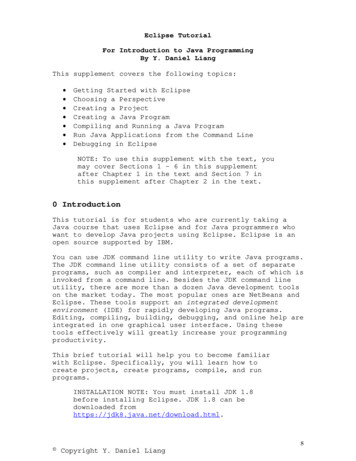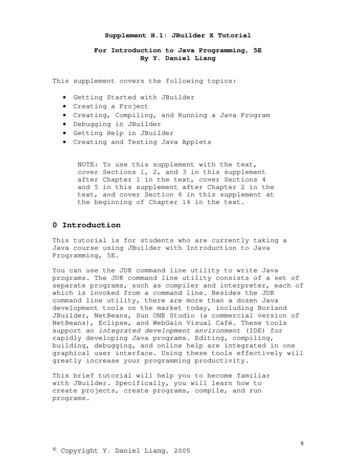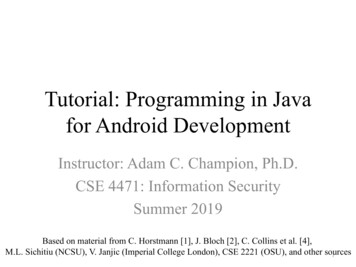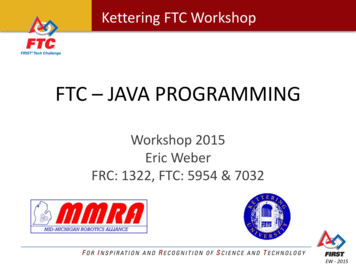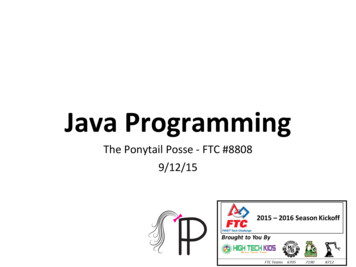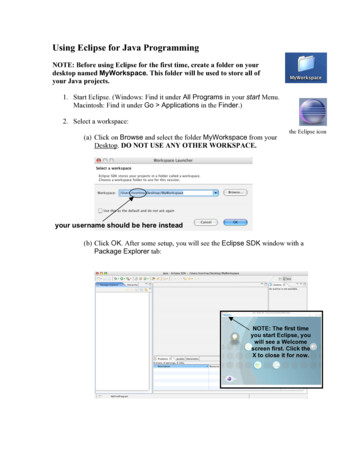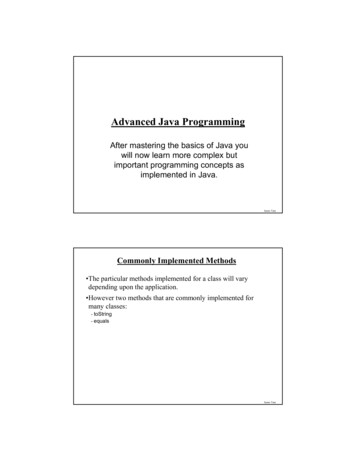
Transcription
Advanced Java ProgrammingAfter mastering the basics of Java youwill now learn more complex butimportant programming concepts asimplemented in Java.James TamCommonly Implemented Methods The particular methods implemented for a class will varydepending upon the application. However two methods that are commonly implemented formany classes:- toString- equalsJames TamCPSC 219: Advanced Java
“Method: toString” It’s commonly written to allow easy determination of the stateof a particular object (contents of important attributes). This method returns a string representation of the state of anobject. It will automatically be called whenever a reference to an objectis passed as a parameter is passed to the “print/println” method. Location of the online example:- /home/219/examples/advanced/toStringExample- www.cpsc.ucalgary.ca/ tamj/219/examples/advanced/toStringExampleJames TamClass Person: Version 1public class Person{private String name;private int age;public Person () {name "No name"; age -1; }public void setName (String aName) { name aName; }public String getName () { return name; }public void setAge (int anAge) { age anAge; }public int getAge () { return age; }}James TamCPSC 219: Advanced Java
Class Person: Version 2public class Person2{private String name;private int age;public Person2 () {name "No name"; age -1; }public void setName (String aName) { name aName; }public String getName () { return name; }public void setAge (int anAge) { age anAge; }public int getAge () { return age; }public String toString (){String temp "";temp temp "Name: " name "\n";temp temp "Age: " age "\n";return temp;}}James TamThe Driver Classclass Driver{public static void main (String args []){Person p1 new Person ();Person2 p2 new Person2 }James TamCPSC 219: Advanced Java
“Method: equals” It’s written in order to determine if two objects of the same classare in the same state (attributes have the same data values). Location of the online example:- /home/219/examples/advanced/equalsExample- www.cpsc.ucalgary.ca/ tamj/219/examples/advanced/equalsExampleJames TamThe Driver Classpublic class Driver{public static void main (String args []){Person p1 new Person ();Person p2 new Person ();if (p1.equals(p2) true)System.out.println ("Same");elseSystem.out.println ("Different");p1.setName ("Foo");if (p1.equals(p2) true)System.out.println ("Same");elseSystem.out.println ("Different");}}James TamCPSC 219: Advanced Java
The Person Classpublic class Person{private String name;private int age;public Person () {name "No name"; age -1; }public void setName (String aName) { name aName; }public String getName () { return name; }public void setAge (int anAge) { age anAge; }public int getAge () { return age; }public boolean equals (Person aPerson){boolean flag;if ((name.equals(aPerson.getName())) && (age aPerson.getAge ()))flag true;elseflag false;return flag;}}James TamMethods Of Parameter Passing Passing parameters as value parameters (pass by value) Passing parameters as variable parameters (pass by reference)James TamCPSC 219: Advanced Java
Passing Parameters As Value Parametersmethod (p1);Pass a copyof the datamethod ( parameter type p1 ){}James TamPassing Parameters As Reference Parametersmethod (p1);Pass the address of theparameter (refer to theparameter in the method)method ( parameter type p1 ){}James TamCPSC 219: Advanced Java
Parameter Passing In Java: Simple Types All simple types are always passed by value in Java.TypeDescriptionbyte8 bit signed integershort16 but signed integerint32 bit signed integerlong64 bit signed integerfloat32 bit signed real numberdouble64 bit signed real numberchar16 bit Unicode characterboolean1 bit true or false valueJames TamParameter Passing In Java: Simple Types (2) Location of the online example:- /home/219/examples/advanced/valueParameters- www.cpsc.ucalgary.ca/ tamj/219/examples/advanced/valueParameterspublic static void main (String [] args){int num1;int num2;Swapper s new Swapper ();num1 1;num2 2;System.out.println("num1 " num1 "\tnum2 " num2);s.swap(num1, num2);System.out.println("num1 " num1 "\tnum2 " num2);}James TamCPSC 219: Advanced Java
Passing Simple Types In Java (2)public class Swapper{public void swap (int num1, int num2){int temp;temp num1;num1 num2;num2 temp;System.out.println("num1 " num1 "\tnum2 " num2);}}James TamPassing References In Java (Reminder: References are required for variables that are arraysor objects) Question:-If a reference (object or array) is passed as a parameter to a method dochanges made in the method continue on after the method is finished?Hint: If a reference is passed as a parameter into a method then acopy of the reference is what is being manipulated in the method.James TamCPSC 219: Advanced Java
An Example Of Passing References In Java:UML Diagram Location of the online example:- /home/219/examples/advanced/referenceParameters- www.cpsc.ucalgary.ca/ river-num :int getNum() setNum()Swap noSwap() realSwap()James TamAn Example Of Passing References In Java:The Driver Classpublic class Driver{public static void main (String [] args){Foo f1;Foo f2;Swap s1;f1 new Foo ();f2 new Foo ();s1 new Swap ();f1.setNum(1);f2.setNum(2);James TamCPSC 219: Advanced Java
An Example Of Passing References In Java:The Driver Class (2)System.out.println("Before swap:\t f1 " f1.getNum() "\tf2 " f2.getNum());s1.noSwap (f1, f2);System.out.println("After noSwap\t f1 " f1.getNum() "\tf2 " f2.getNum());s1.realSwap (f1, f2);System.out.println("After realSwap\t f1 " f1.getNum() "\tf2 " f2.getNum());}}James TamAn Example Of Passing References In Java:Class Foopublic class Foo{private int num;public void setNum (int newNum){num newNum;}public int getNum (){return num;}}James TamCPSC 219: Advanced Java
An Example Of Passing References In Java:Class Swappublic class Swap{public void noSwap (Foo f1, Foo f2){Foo temp;temp f1;f1 f2;f2 temp;System.out.println("In noSwap\t f1 " f1.getNum () "\tf2 " f2.getNum());}James TamAn Example Of Passing References In Java:Class Swap (2)public void realSwap (Foo f1, Foo f2){Foo temp new Foo ;f2.setNum(temp.getNum());System.out.println("In realSwap\t f1 " f1.getNum () "\tf2 " f2.getNum());}} // End of class SwapJames TamCPSC 219: Advanced Java
References: Things To Keep In Mind If you refer to just the name of the reference then you aredealing with the reference (to an object, to an array).- E.g., f1 f2;- This copies an address from one reference into another reference, theoriginal objects don’t change. If you use the dot-operator then you are dealing with the actualobject.- E.g.,- temp f2;- temp.setNum (f1.getNum());- temp and f2 refer to the same object and using the dot operator changes theobject which is referred to by both references. Other times this may be an issue- Assignment- ComparisonsJames TamShallow Copy Vs. Deep Copies Shallow copy (new term, concept should be review)- Copy the address from one reference into another reference- Both references point to the same dynamically allocated memory location- e.g.,Foo f1;Foo f2;f1 new Foo ();f2 new Foo ();f1 f2;James TamCPSC 219: Advanced Java
Shallow Vs. Deep Copies (2) Deep copy (new term, concept should be review)- Copy the contents of the memory location referred to by the reference- The references still point to separate locations in memory.- e.g.,f1 new Foo ();f2 new Foo println("f1 " f1.getNum() "\tf2 " t.println("f1 " f1.getNum() "\tf2 " f2.getNum());James TamComparison Of References Vs. Data(Objects) Location of the online example:- VsObjects- www.cpsc.ucalgary.ca/ sObjectspublic class Person{private int age;public Person () { age -1; }public void setAge (int anAge) { age anAge; }public int getAge () { return age; }}James TamCPSC 219: Advanced Java
Comparison Of The Referencespublic class DriverReferences{public static void main (String [] args){Person p1 new Person ();Person p2 new Person ();p1.setAge(1);p2.setAge(p1.getAge());if (p1 p2)System.out.println("References: Same location");elseSystem.out.println("References: different locations");}}James TamComparison Of The Datapublic class DriverData{public static void main (String [] args){Person p1 new Person ();Person p2 new Person ();p1.setAge(1);p2.setAge(p1.getAge());if (p1.getAge() p2.getAge())System.out.println("Data: Same information");elseSystem.out.println("Data: different information");}}James TamCPSC 219: Advanced Java
A Previous Example Revisited: Class Sheeppublic class Sheep{private String name;public Sheep (){System.out.println("Creating \"No name\" sheep");name "No name";}public Sheep (String aName){System.out.println("Creating the sheep called " n);setName(aName);}public String getName () { return name;}public void setName (String newName) { name newName; }}James TamAnswer: None Of The Above! Information about all instances of a class should not be trackedby an individual object. So far we have used instance fields. Each instance of an object contains it’s own set of instancefields which can contain information unique to the instance.public class Sheep{private String name;:::}name: Billname: Jimname: NellieJames TamCPSC 219: Advanced Java
We Now Have Several SheepI’m Jim!I’m Bill!I’m Nellie!James TamQuestion: Who Tracks The Size Of The Herd?Jim: Me!Bill: Me!Nellie: Me!James TamCPSC 219: Advanced Java
The Need For Static (Class Fields) Static fields: One instance of the field exists for the class (notfor the instances of the class)Class SheepflockSizeobjectname: Billobjectname: Jimobjectname: NellieJames TamStatic (Class) Methods Are associated with the class as a whole and not individualinstances of the class. Typically implemented for classes that are never instantiatede.g., class Math. May also be used act on the class fields.James TamCPSC 219: Advanced Java
Static Data And Methods: UML Diagram Location of the online -www.cpsc.ucalgary.ca/ kSize:intDriver-name: String Sheep() Sheep(newName:String) getFlockSize(): int getName (): String setName(newName: String):void finalize(): voidJames TamStatic Data And Methods: The Driver Classpublic class Driver{public static void main (String [] args){System.out.println();System.out.println("You start out with " Sheep.getFlockSize() "sheep");System.out.println("Creating flock.");Sheep nellie new Sheep ("Nellie");Sheep bill new Sheep("Bill");Sheep jim new Sheep();James TamCPSC 219: Advanced Java
Static Data And Methods: The Driver Class (2)System.out.print("You now have " Sheep.getFlockSize() " sheep:");jim.setName("Jim");System.out.print("\t" nellie.getName());System.out.print(", " bill.getName());System.out.println(", " jim.getName());System.out.println();}} // End of Driver classJames TamStatic Data And Methods: The Sheep Classpublic class Sheep{private static int flockSize 0;private String name;public Sheep (){flockSize ;System.out.println("Creating \"No name\" sheep");name "No name";}public Sheep (String aName){flockSize ;System.out.println("Creating the sheep called " newName);setName(aName);}James TamCPSC 219: Advanced Java
Static Data And Methods: The Sheep Class (2)public static int getFlockSize () { return flockSize; }public String getName () { return name; }public void setName (String newName) { name newName; }public void finalize (){System.out.print("Automatic garbage collector about to be called for ");System.out.println(this.name);flockSize--;}} // End of definition for class SheepJames TamAccessing Static Methods/Attributes Inside the class definitionFormat: attribute or method name Example:public Sheep (){flockSize ;}James TamCPSC 219: Advanced Java
Accessing Static Methods/Attributes (2) Outside the class definitionFormat: Class name . attribute or method name Example:Sheep.getFlockSize();James TamRules Of Thumb: Instance Vs. Class Fields If a attribute field can differ between instances of a class:-The field probably should be an instance field (non-static) If the attribute field relates to the class (rather to a particularinstance) or to all instances of the class-The field probably should be a static field of the classJames TamCPSC 219: Advanced Java
Rule Of Thumb: Instance Vs. Class Methods If a method should be invoked regardless of the number ofinstances that exist (e.g., the method can be run when there areno instances) then it probably should be a static method. If it never makes sense to instantiate an instance of a class thenthe method should probably be a static method. Otherwise the method should likely be an instance method.James TamStatic Vs. Final Static: Means there’s one instance of the field for the class (notindividual instances of the field for each instance of the class) Final: Means that the field cannot change (it is a constant)public class Foo{public static final int num1 1;private static int num2;/* Rare */public final int num3 1;/* Why bother? */private int num4;::}James TamCPSC 219: Advanced Java
An Example Class With A Static Implementationpublic class Math{// Public constantspublic static final double E 2.71 public static final double PI 3.14 // Public methodspublic static int abs (int a);public static long abs (long a);::} For more information about this class go to:- Math.htmlJames TamShould A Class Be Entirely Static? Generally it should be avoided if possible because it oftenbypasses many of the benefits of the Object-Oriented approach. Usually purely static classes (cannot be instantiated) have onlymethods and no data (maybe some constants). When in doubt do not make attributes and methods static.James TamCPSC 219: Advanced Java
A Common Error With Static Methods Recall: The “this” reference is an implicit parameter that isautomatically passed into the method calls (you’ve seen so far). e.g., Foo f new Foo (); f.setNum(10);Explicit parameterImplicit parameter“this”James TamA Common Error With Static Methods Static methods have no “this” reference as an implicit parameter(because they are not associated with any instances).Compilation error:public class Driver{private int num;public static void main (String [] args)Driver3.java:6: non-staticvariable num cannot bereferenced from a staticcontextnum 10;{ num 10;}error}James TamCPSC 219: Advanced Java
Immutable Objects Once instantiated they cannot change (all or nothing)e.g., String s "hello";s s " there"; Changes to immutable objects should be minimizedJames TamMinimize Modifying Immutable Objects (2) If you must make many changes consider substitutingimmutable objects with mutable onese.g.,public class StringBuffer{public StringBuffer (String str);public StringBuffer append (String str);::::}For more information about this class StringBuffer.htmlJames TamCPSC 219: Advanced Java
3. Minimize Modifying Immutable Objects (3)public class StringExample{public static void main (String []args){String s "0";for (int i 1; i 100000; i )s s i;}}public class StringBufferExample{public static void main (String [] args){StringBuffer s new StringBuffer("0");for (int i 1; i 100000; i )s s.append(i);}}James TamBe Cautious When Writing Accessor And MutatorMethods: First Version Location of the online example:- /home/219/examples/advanced/securityVersion1- www.cpsc.ucalgary.ca/ tamj/219/examples/advanced/securityVersion1public class Driver{public static void main (String [] args){CreditInfo newAccount new CreditInfo (10, "James ewAccount);}}James TamCPSC 219: Advanced Java
5. Be Cautious When Writing Accessor AndMutator Methods: First Version (2)public class CreditInfo{public static final int MIN 0;public static final int MAX 10;private int rating;private StringBuffer name;public CreditInfo (){rating 5;name new StringBuffer("No name");}public CreditInfo (int newRating, String newName){rating newRating;name new StringBuffer(newName);}public int getRating () { return rating;}James Tam5. Be Cautious When Writing Accessor AndMutator Methods: First Version (3)public void setRating (int newRating){if ((newRating MIN) && (newRating MAX))rating newRating;}public StringBuffer getName (){return name;}public void setName (String newName){name new StringBuffer(newName);}James TamCPSC 219: Advanced Java
5. Be Cautious When Writing Accessor AndMutator Methods: First Version (4)public String toString (){String s new String ();s s "Name: ";if (name ! null){s s name.toString();}s s "\n";s s "Credit rating: " rating "\n";return s;}} // End of class CreditInfoJames TamBe Cautious When Writing Accessor And MutatorMethods: Second Version(All mutator methods now have private access). Location of the online example:- /home/219/examples/advanced/securityVersion2- www.cpsc.ucalgary.ca/ tamj/219/examples/advanced/securityVersion2James TamCPSC 219: Advanced Java
Be Cautious When Writing Accessor And MutatorMethods: Second Version (2)public class Driver{public static void main (String [] args){CreditInfo newAccount new CreditInfo (10, "James Tam");StringBuffer badGuyName;badGuyName newAccount.getName();badGuyName.delete(0, badGuyName.length());badGuyName.append("Bad guy on the Internet");System.out.println(newAccount);}}James Tam5. Be Cautious When Writing Accessor AndMutator Methods: Second Version (3)public class CreditInfo{private int rating;private StringBuffer name;public CreditInfo (){rating 5;name new StringBuffer("No name");}public CreditInfo (int newRating, String newName){rating newRating;name new StringBuffer(newName);}James TamCPSC 219: Advanced Java
5. Be Cautious When Writing Accessor AndMutator Methods: Second Version (4)public int getRating (){return rating;}private void setRating (int newRating){if ((newRating 0) && (newRating 10))rating newRating;}public StringBuffer getName (){return name;}private void setName (String newName){name new StringBuffer(newName);}James Tam5. Be Cautious When Writing Accessor AndMutator Methods: Second Version (5)public String toString (){String s new String ();s s "Name: ";if (name ! null){s s name.toString();}s s "\n";s s "Credit rating: " rating "\n";return s;}}James TamCPSC 219: Advanced Java
5. Be Cautious When Writing Accessor AndMutator Methods: Third Version Location of the online example:- /home/219/examples/advanced/securityVersion3- www.cpsc.ucalgary.ca/ tamj/219/examples/advanced/securityVersion3public class Driver{public static void main (String [] args){CreditInfo newAccount new CreditInfo (10, "James Tam");String badGuyName;badGuyName newAccount.getName();badGuyName badGuyName.replaceAll("James Tam", "Bad guy onthe Internet");System.out.println(badGuyName "\n");System.out.println(newAccount);}}James Tam5. Be Cautious When Writing Accessor AndMutator Methods: Third Version (2)public class CreditInfo{private int rating;private String name;public CreditInfo (){rating 5;name "No name";}public CreditInfo (int newRating, String newName){rating newRating;name newName;}public int getRating (){return rating;}James TamCPSC 219: Advanced Java
5. Be Cautious When Writing Accessor AndMutator Methods: Third Version (3)private void setRating (int newRating){if ((newRating 0) && (newRating 10))rating newRating;}public String getName (){return name;}private void setName (String newName){name newName;}James Tam5. Be Cautious When Writing Accessor AndMutator Methods: Third Version (4)public String toString (){String s new String ();s s "Name: ";if (name ! null){s s name;}s s "\n";s s "Credit rating: " rating "\n";return s;}}James TamCPSC 219: Advanced Java
5. Be Cautious When Writing Accessor AndMutator Methods When choosing a type for an attribute it comes down totradeoffs, what are the advantages and disadvantages of using aparticular type. In the previous examples:- Using mutable types (e.g., StringBuffer) provides a speed advantage.- Using immutable types (e.g., String) provides additional securityJames TamAfter This Section You Should Now Know Two useful methods that should be implemented for almostevery class: toString and equals What is the difference between pass by value vs. pass byreference The difference between references and objects Issues associated with assignment and comparison of objects vs.references The difference between a deep vs. a shallow copy What is a static method and attribute, when is appropriate forsomething to be static and when is it inappropriate (bad style) What is the difference between a mutable and an immutabletypeJames TamCPSC 219: Advanced Java
After This Section You Should Now Know (2) When should a mutable vs. immutable type be used and theadvantages from using each typeJames TamCPSC 219: Advanced Java
CPSC 219: Advanced Java James Tam Advanced Java Programming After mastering the basics of Java you will now learn more complex but important programming concepts as implemented in Java. James Tam Commonly Implemented Methods The particular methods implemen

